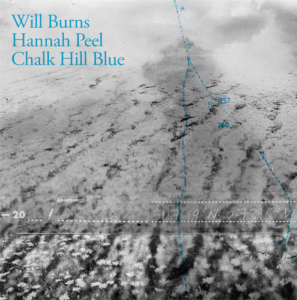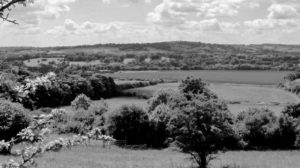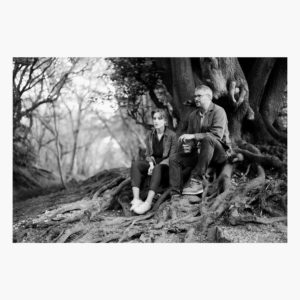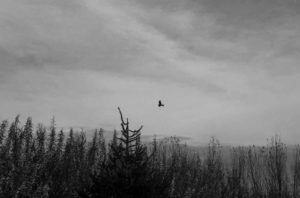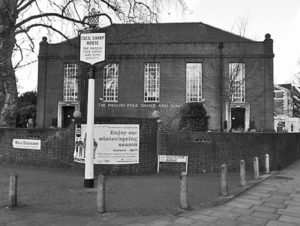Music set to poems, and vice versa, that‘s the program of Chalk Hill Blue. The album is a collaboration of Will Burns, Hannah Peel, and Erland Cooper. When I sent my questions to Will, I hadn’t heard a single note of the music, his poems were my starting point, and a fascinating one. I let the lines work on my mind, my unconscious, strolling, roaming, meandering, and kept asking myself how they all would sound when surrounded by music. Knowing Hannah Peel for some of her sensitive arrangements of other people’s music, and from her own solo work, especially the fantastic Mary Casio – Journey to Cassiopeia, my fantasies grew wild, besides I was looking for some pictures of Will‘s surroundings in Derbyshire. Now that I got his answers (and one from Hannah), I‘m even more grateful for some translations of the poems by German and Austrian poets Martina Weber („February“) and Astrid Nischkauer (the other ones). Four poems will be part of my next radio night at the Deutschlandfunk on April 20. Meanwhile the music had arrived. In the evening I turned the lights down low, a glass of red wine, and then, some deep listening. What an aural delight, even in its darker moments – the whole thing a consciousness-jolting affair! This album, earthbound and elevating, will find its place on my shelf in the good neighbourhood of Darren Hayman‘s immersive hinterland journeys of „Thankful Villages“. Chalk Hill Blue will be released on Friday.
Frühlingserwachen auf der meschuggenen Meile
Noch lässt sich der Tag nicht
nach dem Wetter bestimmen.
Keine Helligkeit oder kein struktureller
Schatten verrät
den Umriss oder Körper von etwas–
vom Wald, dem Fluss, dem Gästehaus.
Man könnte vom Vorhang
und dem Luftzug über den Rücken träumen,
vom Freien, der Hitze.
Oder vom Vogelgesang, der scheinbar
überall ist, und von einem Gefühl
des Unbekannten erzählt, mit welchem
diese Stunde allein beladen ist. Es breitet sich aus
wie ein Ausfließen, das zu einem Dröhnen wird.
Michael Engelbrecht: The modus operandi seems to be that Hannah Peel used your poems as inspiration for the music. But at the very beginning Hannah had some music that suggested a poem to you. Is „Spring Dawn on Mad Mile“ such a piece – some motives from the „aural field“ at least suggest that. Whatever, can you tell something about the relation of sounds and words here?
Will Burns: Well I think with that piece, Hannah and Erland had started to create some sounds, I think they had a synthesiser going, and there was just something about the mood that suggested that poem to me – an oppressive quality, maybe. That was how we started with a few of the recordings. But after that, we would try reading the poem over the top of the synth or drum machine or whatever it was, and figure out how the music of the poem itself could work with or against the compositions that Hannah was creating. Were there moments of harmony? Moments of tension? Did they make sense? That was the process really – and also how the words and music established a relationship.
Is the cover of the album a kind of „signifier“ for the landscapes that inspired the album, and can you describe your personal relationship to that special landscape – I don‘t know if England‘s famous literary wanderer, Robert MacFarlane, ever crossed this area?
Yes the cover is very much a representation of that place, but also of the slightly blurred or murky quality the place has. It’s not a wild place, it’s not urban, it’s not really suburban either. There are aspects of the place that feel very rural – the farming, the forestry, but you can feel the commuter-ness of it all as well. There are people around my village with proper old Bucks accents (like my Grandad), but also lots of London overspill and that kind of placeless Southern Englandness to it as well. That’s the tension that keeps pulling me into the place, I suppose, in the work. I think Robert walked the Ridgeway a couple of years ago and was in the area. I’d be surprised if he hadn’t been there a number of times.
How did Hannah Peel approach the landscape, primarily through your poems – or did you two take some free time for wandering around. You might have memories about common walks, the exchange of stories, the sharing of silence …
Hannah and Erland both came out to visit, along with Chris Turner, who shot the artwork imagery, and we walked a section of the Ridgeway. It was the start of that hot summer last year, and we’d recorded some stuff already but I think having all three of us in the landscape focused what we were doing somewhat. I think Hannah saw the hills, the pub, the woods and maybe it gave the stories and poems some extra colour somehow. A good walk is never a bad thing, I don’t think.
You mention some „echo spaces“ of the music, sort of distant cousins, for example Roedelius „kosmische reverie“. Do you have favourite albums by Roedelius or Cluster who indeed, were good examples for going back to nature in the mid-70‘s celebrating a more meditative lifestyle …
Well I think Hannah might be best placed to talk about that. For me, I’ve liked lots of electronic music and certainly Neu! and Kraftwerk and bits of Can, but I think I was most excited about the Daphne Oram and Delia Derbyshire references really. And when Hannah first sent me the mixes they’d done with the bits of woodwind on, that took me back to listening to Peter and the Wolf as a child. My Dad played the David Bowie version a lot and the flutes sort of stuck with me.
Februar
An Abenden wie diesem könnte ich alles vergessen –
Namen, Adressen, sogar die Art, wie wir zueinander standen.
All das könnte aufgenommen werden
von den Lichtern der Stadt bei diesem Wetter.
Der Vorgang hat etwas mit den Gebäuden zu tun,
ihrer Bauweise aus Quarz und Ziegelgestein,
aber es geht auch um die Belange der Menschen.
Wie viele es sind … können wir´s wissen? Den Daten trauen?
Die Grenzhunde, die es auflecken,
sie werden ihre Gründe haben.
Und es gibt überall Hunde, wo eine Linie gezogen wird.
Die Anzeige auf meinem Smartphone sagt mir (nicht nur, wo ich bin,)
sondern dass ich in 15 Minuten anfangen kann mit meinem ersten Drink.
Und das sind alle Neuigkeiten, mit denen ich umgehen kann.
„February“ catches up a special evening atmosphere. On the one hand reflecting borders, on the other a more immersive experience with that funny line about the drink at the end. Was there a special inspiration for the poem, or is it more a condensation of a certain mood?
One of those rare things that comes to you out of nowhere, almost in one go… I was walking through London at the time in fact, and almost certainly felt a mood descend that seemed to want to be dealt with, however one attempts to try and deal with that sort of thing. Sometimes it’s by writing. I suppose I’d been thinking a lot about borders – who hasn’t the last few years? – and what they mean, how they work imaginatively, on maps or in our psyche. The phone, the map itself is a kind of border too I suppose. They both mediate our experience of place.
What was the special role and contribution of musician and producer Erland Cooper for the album? Was he suggesting a certain sound, did he add musical colours, ideas, or was his role like more defined by shaping the tracks into a coherent whole?
I think Erland added a real urgency to the pace of the work, he got things recorded quickly, didn’t allow us to worry unduly about things until we needed to, so that the project evolved rather than being set out in too prescriptive a way at the outset. He had musical ideas, definitely … he and Hannah would be in dialogue about the sounds and layers. And then he’d agree about a poem if I thought one might work, or the opposite of course. And then sequencing, mixing, mastering. He was a vital part of the process.
„The Night Life“ sounds quite surreal, one of the poems here I think have to use a dictionary to get closer to the gist. Can you shed some light on this one?
That’s definitely one where Hannah made some music first, which we sort of worked out of. I think it’s a drum machine she used to create that unrelenting, slightly frightening rhythm. It just sounded instantly to me like the poem I had tried to write. It’s about that sense you have at certain times in your life that things are getting out of hand. And most of the time when you look at what’s going on in those periods, perhaps try and analyse what’s happening a bit, you see that things had got out of hand a while ago in fact but you somehow missed the signs.
Looking back on the album, what can you say about Hannah Peel‘s contribution: did she offer new insights from a reader‘s / musician‘s perspective, did she enhance certain moods? From my point of view, as someone who has been reading the lyrics, but not heard any of the tracks, I imagine she has worked in a more ambient mood, with a very ascetic use of rhythm or groove.
That’s spot on, rhythm is quite a difficult aspect of the music in this kind of project because language has such a strong rhythm of its own when being spoken rather than sung. So the music had to sit alongside the syllabic rhythm of the poems, which I think pushes it towards the ambient, or the textural. Hannah would have the language to talk about it more accurately I’m sure, but for my part, I felt that she just had a very astute understanding of the poems on a musical level, she almost worked with them as if they were an instrument, which of course is one way that poems do their work. And yet she’s also got a very keen ear for poetry conceptually as well, she might only have said a few words about it after hearing a poem for the first time, but those words always suggested to me that she’d read the poem in interesting ways.
„A Summer Blues“ is one that appeals to me on first sight. It‘s a bit like a short story disguised as a poem. Such lines as „… and guitar strings that might rust to blue or ring forever …“ create a mood that is really a bit blues-like, but even in these night moods some magic seems to be hidden, in spite of „youtube clips“.
That’s very kind, thank you. I suppose it belongs in the same family as „The Night Life“ in some ways. An appraisal of where one is at a certain time. What kind of a mess one’s made of things …
Do you have favorite spoken word albums that may once upon a time had, or still have, a deep impact on you? The Books, Brian Eno, Laurie Anderson, Jan Bang and Erik Honoré, quite some artists have worked in this area in recent years …
Well I’ve mentioned Peter and the Wolf. I suppose I should also say that I grew up listening to lots of what are now called audio books. At the time they were just tapes that I loved as much as music. BBC radio adaptions – obviously the Hitchhikers Guide to the Galaxy, but also PG Wodehouse and Tolkien – loads of other stuff. I think that’s meant I’ve always carried the idea that literature is something that lives on the breath as well as the page. I have a huge admiration for Alice Oswald, whose work in some ways seems to refute the tyranny of print – posits the idea of the poem as something spoken and heard at least as much as something read on paper. She’s a fantastic poet. But in terms of recordings, I’m not sure I’ve got any favourite records that are similar really, which is one of the reasons I was so excited to make the recordings with Hannah and Erland. It felt as if I was living on my nerves creatively and completely free from what can sometimes become comfortable reference points.
Im Freien
Wir kannten den Sonnenaufgang als Gelsenzeit,
die sich selbst erschöpft
im dampfigen Wald,
und den tatsächlichen Wahnsinn
eines aufgenommenen Morgenchors.
Wir machten unsere Feldaufnahmen
um nichts davon zu verlieren.
Später, als ich sein Haus ausräumte,
fand ich das Aufnahmegerät.
Ich drückte auf den Startknopf und sah zu,
wie sich das Magnetband durch die Rollen spulte,
das Band straff am Tonkopf,
der Bandantrieb funktionierte immer noch,
war perfekt im Takt.
Wöchentlich eine Stunde verbringe ich
nun damit, die sich verändernden Grüntöne
im Garten seines Pflegeheimes zu beobachten.
Er versteht nicht mehr, was es ist,
das ich ihm da vorspiele,
wie die Aufnahme des Vogelgesangs
sich in den Räumen ausbreitet,
die sich zwischen uns auftun, während wir
dasitzen in diesem, seinem letzten erleuchteten Raum.
Looking back at the project, Hannah Peel wrote these lines: „A thrill from coming to make art together with no preconceptions, just a pure admiration for another artist‘s work and sensing a deep urge to create something to compliment that. There wasn’t many challenges when making the album, under the watchful hands and ears of producer Erland Cooper he was able to capture exactly the mood of the room, the poetry, the synths, drum machines and atmospheres I was turning to instinctively and embellished them with added tape loops, delays and his own processes. As the album was made so reactively towards each other in the room, the biggest challenge has been to take that live on stage and how to re-create that magic, impulses and connection so an audience can feel like they are in the room with us observing the process!“
Will and Hannah will be performing „Chalk Hill Blue“ live:
30.03.19 – Caught By The River Calder at The Trades Club – HEBDEN BRIDGE
04.04.19 – Cecil Sharp House – LONDON
05.05.19 – Cathedral Quarter Arts Festival – BELFAST
11.05.19 – Queens Hall – EDINBURGH
24.05.19 – Sea Change Festival – TOTNES
28.07.19 – Port Eliot Festival – ST GERMANS
01.11.19 – The Civic, Assembly Room – BARNSLEY
Ridgeway
It could be the dogs announce
your visit. It could be her birds.
However it happens, she knows—
understanding that has come unmoored.
She opens red wine, puts out a bowl.
Outside in the fields the second
hay crop is cut and turned again,
a faded day, dirt that might have been
yours to own. An inheritance, like so much
taken on faith, held in seed.
